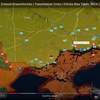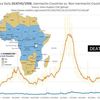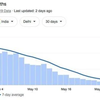Nú segja þeir að bóluefnið sé að koma.
Getum við treyst yfir stofnunum, sem eftir því sem ég veit best, bönnuðu, hvað?
Uppruninn er? KÍNIN, synthesized ? chloroquine, ? hydroxychloroquine, ? HCQ, ???
Við munum eftir að einhverjar yfirstofnanir, rannsökuðu lyfið, fréttir komu um að lyfið, væri ekki öruggt.
Margir hættu að nota lyfið. Sviss hætti, og dauðsföllum fjölgaði. Margir læknar sögðu að lyfið virkaði mjög vel. Þá byrjaði Sviss að nota lyfið aftur. Þá fækkaði dauðsföllum í það sem áður var.
Ísrael hætti að nota lyfið, og dauðsföllum fjölgaði um 400%. Þetta var í greinum sem ég bloggaði um á netinu.
Vonandi eru það ekki sömu aðilar sem stjórnuðu rannsókninni, og vilja nú selja okkur bóluefnið.
Mér skilst að Bandaríkjastjórn hafi látið Bandaríska herinn hafa yfirstjórn yfir framleiðslu á bóluefni, er það öruggara?
Hvað dóu margir vegna þessara, spurning, lyfja átaka? atburða?
000
This site is created by a board-certified ER physician to bring us together for better health, safety, and for the sharing of knowledge.
History of Hydrochoroquine: From Quinine to Covid-19
Chronological history of the discovery of quinine as it progressed to the discovery of quinoline derivatives to the present use of hydroxycholoroquine in the treatment of SARS-CoV-2 (aka COVID-19)
.
Pre 1638
According to this legend, an Indian with a high fever was lost in an Andean jungle. Thirsty, he drank from a pool of stagnant water and found that it tasted bitter. Realizing that the water had been contaminated by the surrounding quina-quina trees he thought he was poisoned. Surprisingly, his fever soon abated, and he shared this accidental discovery with fellow villagers, who thereafter used extracts from the quina-quina bark to treat fever. (2)
.
1638
Spanish Countess of Chinchon
The legend of quinine’s discovery accepted in Europe differs though, and involves the Spanish Countess of Chinchon who, while in Peru, contracted a fever that was cured by the bark of a tree. Returning to Spain with the bark, she introduced quinine to Europe in 1638 and, in 1742, botanist Carl Linnaeus called the tree “Cinchona” in her honour. (2)
.
1650
English physician, Thomas Sydenham (1624 – 1689), separated out malaria as one of the causes of fevers. He was instrumental in establishing the “Peruvian bark” as one of the first practices of a specific drug therapy. By 1650 shipments of cinchona bark were being regularly sent to Spain from its colonies. (3)
The bark of the cinchona tree was first dried, ground to a fine powder, and then mixed into a liquid (commonly wine) before being drunk.
Quinine and other cinchona alkaloids (quinine, cinchonine and cinchonidine) were all shown to to be effective against malaria.
Cinchona Bark
1820
Pierre Joseph Pelletior and Joseph Caventou were able to isolate quinine through extraction. Purified quinine then replaced the bark as the standard treatment for malaria. (5)
.
1866-1868
The efficacies were tested in one of the earliest clinical trails which was conducted in 1866 to 1868 in which 2600 patients were treated with the 3 alkaloids extracted. With the main outcome measure of “cessation of febrile paroxysms,” all four alkaloids were found to be comparable, with cure rates of >98%. However, after 1890 quinine became the predominantly used alkaloid, mainly due to a change in supply from South American to Javan cinchona bark, which contained a higher proportion of quinine. Quinine remained the mainstay of malaria treatment until the 1920s, when more effective synthetic anti-malarials became available. (4),(5)
.
1934
Chloroquine was first discovered by Hans Andersag while working for Bayer AG. (6) It was introduced in the 1940’s, is a member of an important series of chemically related antimalarial agents, the quinoline derivatives. (7)
The quinolines are an important group of compounds such as nicotinic acid (Vit B3), cyanine dyes, and of course quinine and its synthetic derivative chloroquine and hydroxychloroquine.
Original protocol for the synthesis of chloroquine (Resochin) Hans Andersag 1934
It is on the World Health Organization’s List of Essential Medicines, the safest and most effective medicines needed in a health system. It is available as a generic medication The wholesale cost in thedeveloping world is about US$0.04 In the United States, it costs about US $5.30 per dose.
CDC website on the Antimalarial drug Chloroquine
8-22-2005
Chloroquine is a potent inhibitor of SARS Coronavirus Infection and Spread
Summary:
Original 2005 article concluding Choroquine was effective for treatment and prevention of SARS Corona Virus
.
Feb 4, 2020
Summary
Remdesivir and chloroquine are highly effective in the control of 2019-nCoV in vitro. Chloroquine is relatively cheap and safe in that it has been used for over 70 years.
Comments:
Chloroquine mechanism of action is by increasing the endosomal pH required for virus/cell fusion, as well as interfering with the glycosylation of cellular receptors of SARS-CoV-2.
.
Feb 11, 2020
Chloroquine for the 2019 novel coronavirus SARS-CoV-2
Summary
Raoult of Marseille University proposes a study to look at Hydrochloroquine and Azithromycin combination in the treatment of SARS-CoV-2
.
Feb 13, 2020
Physicians work out treatment guidelines for coronavirus
Summary:
Korean protocols utilizing Hydrochloroquine 400 mg daily (or Chloroquine 500 mg daily)
with Lopinavir 400 mg/ritonavir 100 mg (Kaletra 2 tabs BID)
Comments:
Caution related to QT prolongation with this combination.
.
Feb 20, 2020
Expert consensus on Chloroquine phosphate for the treatment of novel coronavirus pnuemonia
Summary:
Health Commission of Guangdong Province, China showed that Chloroquine at 500 mg BID for 10 days could shorten hospital stay and improve outcomes.
.
March 13, 2020
An Effective Treatment for Coronavirus (CoVid-19), in consulatation with Standord University School of Medicine and UAB School of Medicine and National Academy of Sciences Researchers
Summary
Chloroquine, according to the Korean and Chinese human treatment guidelines, can effectively treat Covid-19. Given its human safety profile it could be used treatment.
They stated, “the United States and other countries should immediately authorize and indemnify medical doctors for prescribing chloroquine to treat COVID-19”.
Called for its use preventively as well as for treatment of disease.
.
March 16, 2020
Summary:
Despite a small study, there was statistically evidence that Hydrochloroquine and Azithromycin had a synergist effect superior to controls and Hydrochloroquine alone. Recommended further study.
Comments
- Improvements were noted at day 3 to 6 days of treatment compared to controls.
- Pointed out the potential of severe QT prolongation by the combo should be considered.
.
March 28, 2020
Click for the link to FDA approval for the use of Chloroquine and Hydrochloroquine to treat Covid-19
Summary:
FDA approves use of Chloroquine and Hydrochloroquine for treatment in adults and adolescence who’s weight is 50 kg or greater. This is an off-label approval for patients for whom no clinical trial is available
.
Key Doctors leading to the approval and validation of Hydrochloroquine and Azithromycin:
French researcher Dr. Didier Raoult has now treated 1000 coronavirus patient with 99.3% success rate [Update]
New updates from Dr. Vladimir Zelenko: Cocktail of Hydroxychloroquine, Zinc Sulfate and Azithromycin are showing phenomenon results with 900 coronavirus patients treated
References:
- https://www.britannica.com/science/quinine
- http://historyofmalaria.com/2010/02/cinchona-bark/
- https://www.britannica.com/biography/Thomas-Sydenham
- Dobson SMaM. In: Antimalarial Chemotherapy: Mechanisms of Action, Resistance, and New Directions in Drug Discovery. PJ R, editor. Totowa, New Jersey: Humana Press; 2001. The history of antimalarial drugs; pp. 15–25. [Google Scholar]
- https://www.ncbi.nlm.nih.gov/pmc/articles/PMC3121651/
- https://en.wikipedia.org/wiki/Hans_Andersag
- https://www.britannica.com/science/quinoline







Bæta við athugasemd [Innskráning]
Ekki er lengur hægt að skrifa athugasemdir við færsluna, þar sem tímamörk á athugasemdir eru liðin.